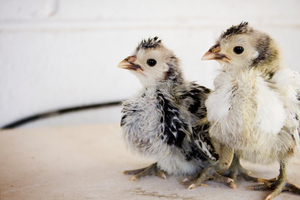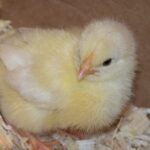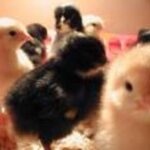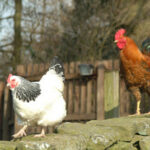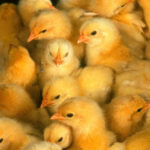When choosing to start a flock of chickens for the backyard, you have several options. One option is to purchase hens already at laying age from a local farm. This can be a simple start to owning chickens, however the downsides are numerous.
Adult chickens have unknown exposure to diseases, which can rapidly spread through your flock and kill your birds or leave you with chickens who lay very few eggs. Adult chickens are also usually not tame unless they have been hand raised by the farmer. They may warm up to you with time, but they won’t ever be as friendly as chickens you’ve raised from little chicks. Adult chickens are also considerably more expensive to purchase than chicks.
Raising baby chicks can be an enjoyable experience for a family. They are very simple to care for, and after a few months you’ll have friendly healthy chickens who are beginning to lay their first eggs!
The first thing to consider before purchasing chicks is the season. Baby chicks require a heat lamp for their first few months of life, so they must be kept indoors or in a garage. (Putting a heat lamp in an outdoor chicken coop is a fire hazard!) If you purchase your chicks in the fall or winter, they will need to remain under the heat lamp considerably longer than if you purchase chicks in the spring. If the weather is in the 60’s or 70’s outside during the day by the time the chicks are 8 weeks old, you can go ahead and put them outside day and night in their coop.
The cage with a heat lamp baby chicks are kept in is called a brooder. Choose carefully where you will brood your chicks. Baby chicks need space to go underneath of a heat lamp, and they also need space to get out of the heat should they become too warm. They will need space for food and water as well. Keep in mind that chicks create dust that will coat the surface of whatever room you keep them in! If their bedding is changed every few days the odor is minimal.
You will need the following items to set up a brooder:
-Cage/enclosure
-Lid for brooder
-Heat lamp with red light bulb (and a secure place to clip or hang the lamp from)
-Thermometer
-Bedding
-Food dish
-Water dish
-Chick feed
Some ideas of simple chick brooders include large refrigerator boxes, rabbit cages, Rubbermaid tubs, or a homemade cube-shaped frame with hardwire cloth on all sides. Whatever you choose for a brooder, keep in mind that the chicks will be able to fly before they are ready to leave the brooder! Unless you are alright with the room they are staying in being coated in chick poop, choose a brooder that has a removable lid. For example, if you choose a Rubbermaid tub, purchase a large wire lid from the pet store to lay over the top. This will also help protect the chicks from household pets, especially curious cats.
Consider what type of bedding you will use for your chicks. It’s not a good idea to keep chicks straight on a wire floor because their feet can get caught, even in tiny gaps, or they can get sores from the wires which will quickly get infected. (Bumble Foot is the illness a chick has when a staph infection enters a sore on the pad of the foot.)
The first few days of a chick’s life are best spent on paper towels for bedding. Baby chicks sometimes have trouble toddling around on little legs for a few days, so they might have trouble getting through bedding. They also sometimes get confused and try to eat the bedding! Paper towels can be changed easily and quickly to rid of bad odor.
Newspaper or hard plastic are not safe surfaces for chicks due to the lack of traction. Chicks can slip and harm their legs. Chicks with legs splayed out to the sides are called spraddle legged. Sometimes this can be repaired by aligning the chick’s legs using a band aid cut in half long ways and leaving it on for two weeks. These chicks have a difficult start since they often aren’t able to get to the food and water, or they get trampled under the other healthy chicks.
After a week, chicks are strong enough to have pine shavings for their bedding in place of the paper towels. Do not use cedar shavings, as there is some debate that cedar is toxic to chickens. Pure, low dust pine shavings are the safest bedding for brooders or coops.
Water and food dishes must be carefully selected. Small chicks are drawn to water and can drown easily in an open bowl. Small chick sized waterers can be purchased at a feed store. These can be tipped over easily, however, and you will find a brooder full of soaking wet chicks! The chicks also somehow manage to fill their food and water with shavings and poop, making a disgusting soup for you to clean out. If you are using a rubbermaid tub or other fully enclosed container for your brooder along with a chick waterer, be sure to poke a drainage hole in the bottom of your brooder. That way if the waterer is full and gets knocked over by over active chicks, it will not flood their enclosure and drown them. There’s nothing more sad than waking up to find a brooder of drowned chicks! (It’s also recommended to drill a few ventilation holes near the top if you choose a Rubbermaid tub for a brooder so that the chicks don’t over heat.)
Another watering option is a hamster or rabbit water bottle with a metal ball in the tip. You can easily teach chicks to peck the metal ball to get water out, and the water always remains clean. There is little risk of it spilling and it’s easy to refill. Once the chicks grow up and go outside, you can purchase larger 64 ounce rabbit water bottles from most pet stores to hang on the side of their pen.
Regular chick feeders function fine for small chicks. To avoid the feeder getting filled with pine shavings, make a platform of bricks to set the feeder on top of. That way the chicks can hop up on the platform to eat. (In the first few delicate days you can set the feeder directly onto the paper towel bedding.)
Since baby chicks have down instead of feathers, they have no way to retain body heat on their own. A metal heat lamp with a black clip can be purchased at most farm supply stores. The lamp should have a 250 watt bulb. A red bulb is the best choice so that chicks are able to establish a day and night routine. The red light doesn’t keep them awake at night like a regular white bulb would.
The heat lamp should be secured above one side of the brooder so that the chicks can sleep on one side, and cool down on the other side. Their food and water should be on the opposite side of the brooder than the heat lamp.
The temperature under the heat lamp should be right around 99 degrees for the first week of life. The temperature can slowly be lowered by five degrees each week after that.
Your chicks will let you know whether they are hot or cold. Cold chicks will huddle together and peep loudly. If chicks are not able to stay warm enough they won’t have enough energy to eat and drink, and they won’t thrive. If chicks get too cold for too many hours they will die. They will usually peep loudly, begging to be warmed up!
Hot chicks will stand far apart from each other and pant, and they may also become lethargic.
Normal behavior for chicks is for them to stretch out and nap (looking quite dead sometimes!) either laying next to each other or snuggled in a pile. Chicks sleep a lot during their first few days of life.
Once you have a brooder fully prepared or planned for your chicks, it’s time to order them or buy them from the feed store or farm. Most feed stores sell chicks during late March and early April. State laws vary, but many locations require that chicks be sold in groups of a certain number. A common number required is six chicks at a time.
When choosing where to order from, consider what purpose you want chicks for. If you want laying hens, you will want to order or purchase pullets or all female chicks. Straight run chicks are a mix of male and female, and often there is a higher number of males. If you want chickens for meat, you can either purchase males (cheaper than females) or get straight run chicks.
There are a few breeds of chicks called Sex Links which can be sex based on their down colorings at hatch. Sex links are chickens who lay eggs daily, they are bred for laying. They come in several different colors and are often sold at feed stores for Easter.
Usually chicks purchased at a farm are straight run. Hatcheries sell chicks both sexed or straight run, with the female chicks (pullets) costing more than the males. When ordering from a hatchery be prepared to receive extra chicks in your order if the weather is cool. Hatcheries call these extra chicks “packing peanuts” because they are used to stuff the box to keep the chicks you order warm enough during the trip through the postal service. These “packing peanuts” are almost always roosters. There is also a slight risk that your female chicks will be sexed wrong and you could end up with a surprise rooster. Roosters can be easily re-homed through sites like Craigslist if you aren’t able to keep a crowing rooster in your area.
Heat up your brooder a few days before getting your chicks. This way you can monitor the temperature to be sure it’s not too hot or cold at various points during the day. Once your chicks arrive, dip the beak of each chick into the water and into the food so that they know where everything is. If your chicks have come through the mail it’s sometimes a good idea to add a bit of sugar to their water to perk them up after the long journey.
After about 8 weeks chicks will be fully feathered out and, depending on the season, they can leave the brooder and join the outside world.
Enjoy raising your chicks! You’ll be able to spend the next four or five months hand taming your chickens, and then you’ll be rewarded with that exciting first egg!
